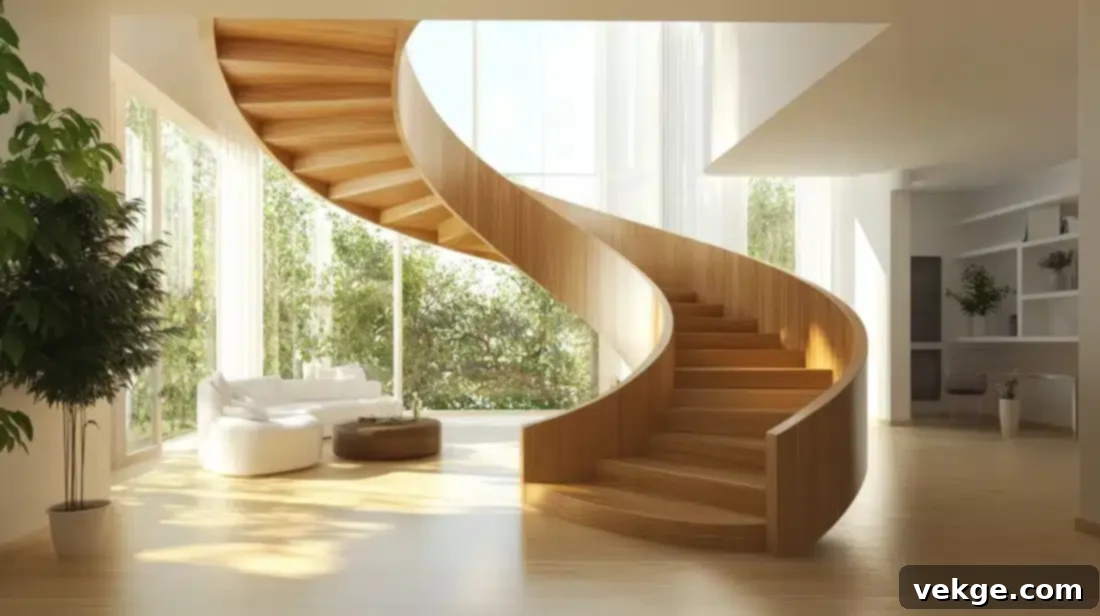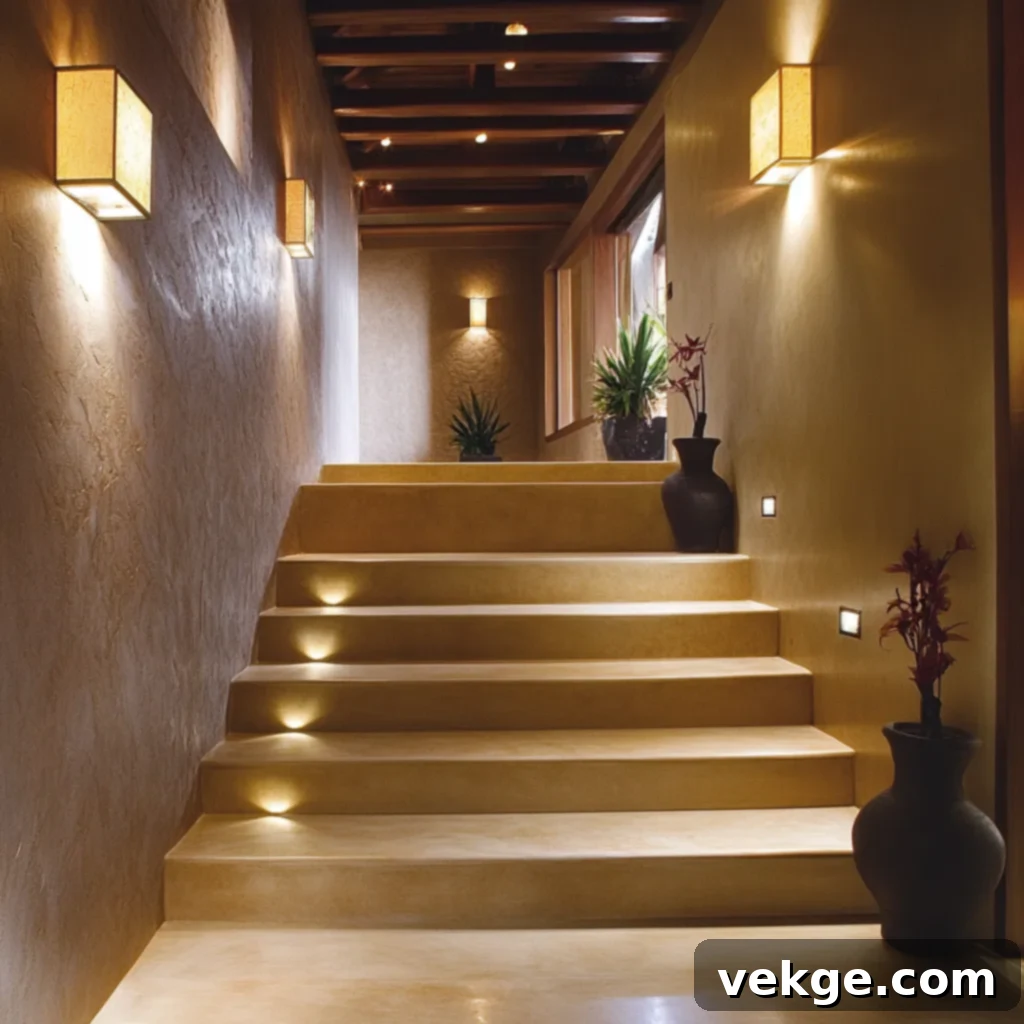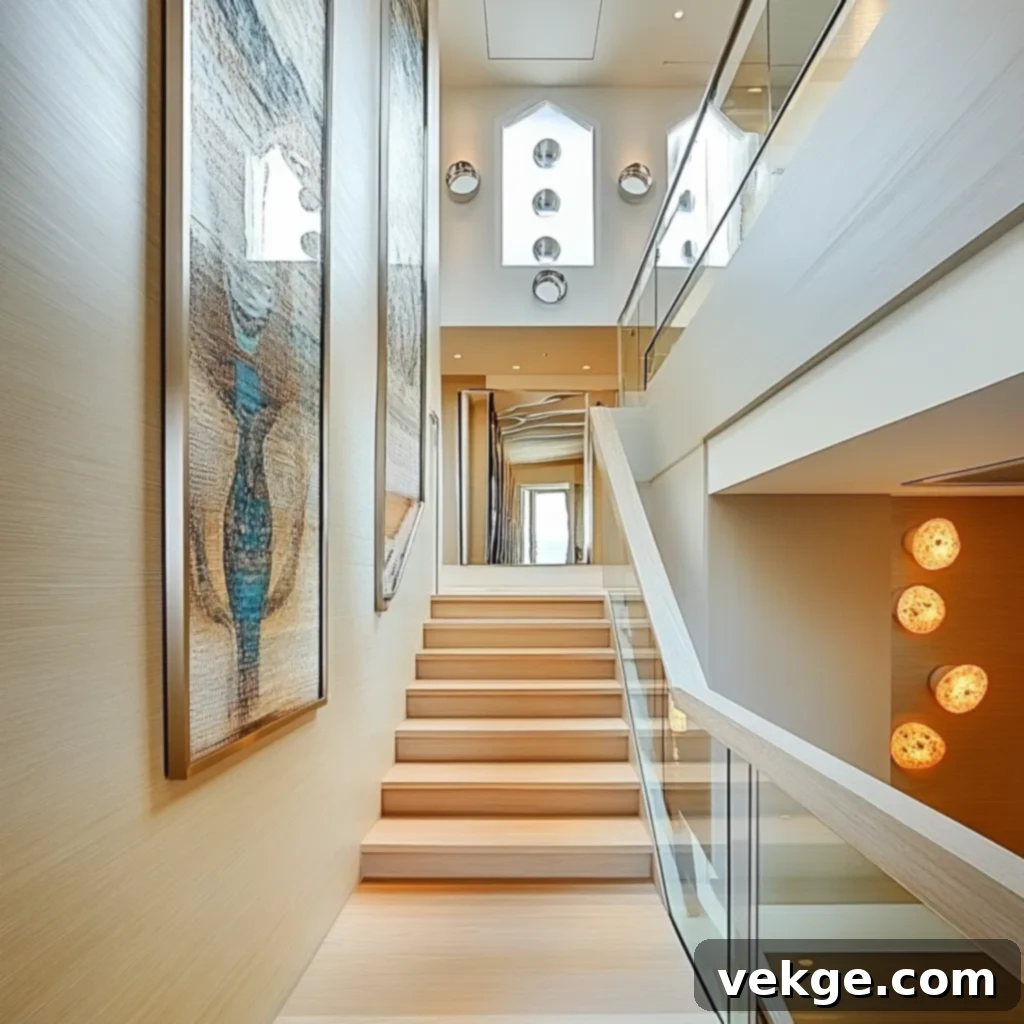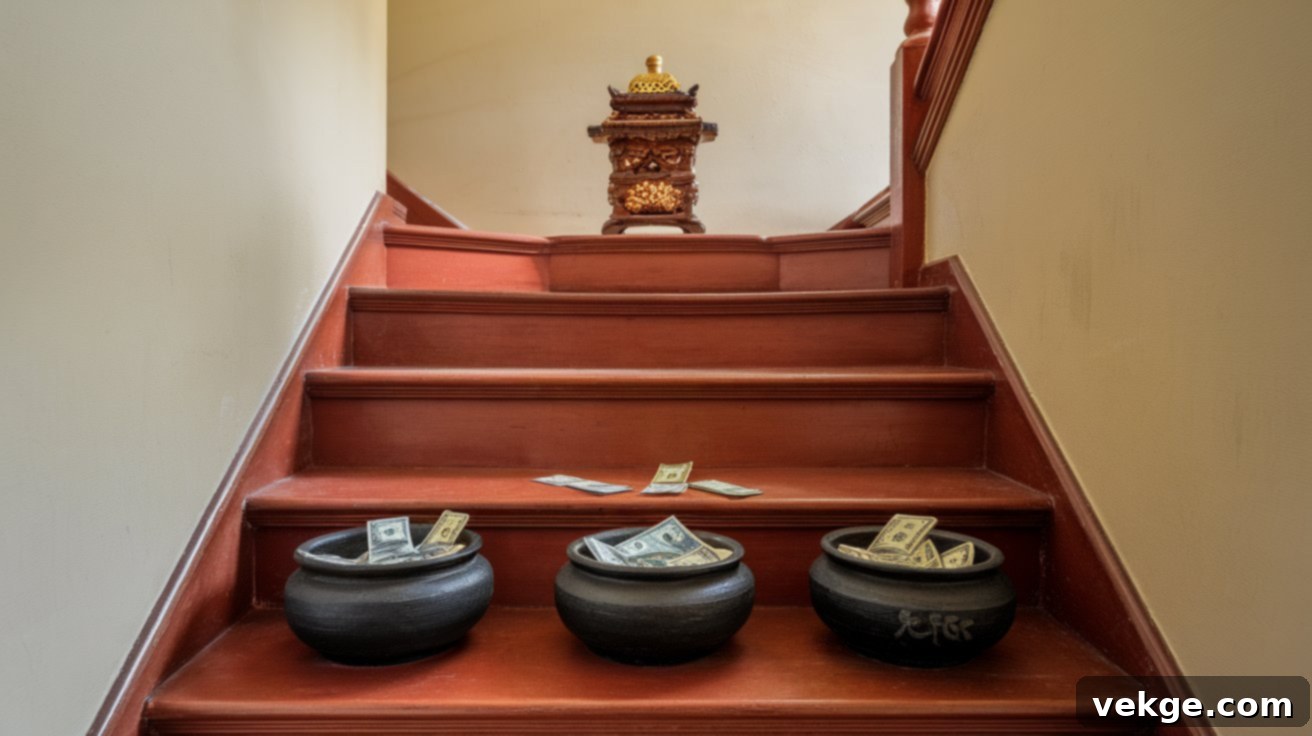Mastering Feng Shui Stairs: Design for Harmony and Positive Energy Flow in Your Home
Staircases are far more than just functional connectors between different levels of a home; they are vital conduits for energy, significantly influencing the overall harmony and balance of your living space. In the ancient practice of Feng Shui, the design, placement, and even the number of steps in a staircase can profoundly impact the flow of ‘chi’ – life force energy – affecting everything from your health and prosperity to your relationships.
While many often focus solely on counting steps for good Feng Shui, the truth is that a holistic approach is essential. This comprehensive guide will delve deep into the secrets of Feng Shui stairs, moving beyond simple numerical counts to explore key principles, common pitfalls, and practical solutions. You’ll learn how to design, enhance, and optimize your staircase to create a continuous flow of positive energy throughout your home, fostering well-being, success, and a sense of calm.
Prepare to transform your staircase into a powerful ally in creating a truly harmonious and energetic home environment.
The Foundational Principles of Feng Shui and Their Connection to Staircases

Feng Shui, an ancient Chinese art and science, is dedicated to creating harmonious living spaces by understanding how energy interacts with our environment. This wisdom is particularly relevant when considering staircases, as they are dynamic architectural features that directly impact the vertical movement of energy within a home.
Understanding Feng Shui: Definition and Core Principles
At its core, Feng Shui is about balancing the environment to promote the free and positive flow of chi. By intentionally arranging our surroundings, we can influence our experiences and overall well-being. This practice is founded on several key principles:
- Chi (Qi): This is the universal life force energy that permeates everything. In Feng Shui, the goal is to ensure chi flows smoothly, gathers auspiciously, and doesn’t become stagnant or rush away too quickly. A well-designed staircase guides chi gently upwards and downwards, enriching all levels of the home.
- Yin and Yang: This fundamental concept emphasizes the importance of balance between opposing forces – light and dark, active and passive, solid and void. In staircase design, this translates to balancing openness with security, light with shadow, and movement with stillness.
- Five Elements: Wood, Fire, Earth, Metal, and Water are the foundational elements that describe various forms of chi and their interactions. Each element corresponds to specific colors, shapes, materials, and directions. Understanding these elements can help in choosing appropriate materials, colors, and decorative items for your staircase to create balance and support specific intentions. For instance, wood stairs bring growth energy, while metal stairs can introduce clarity and precision.
- The Bagua Map: While not always directly applied to a single staircase, the Bagua map is a powerful tool for analyzing energy flow in different areas of a space. Each section of the Bagua corresponds to aspects of life such as health, wealth, and relationships. Knowing where your staircase falls within your home’s Bagua can offer insights into its potential impact on specific life areas.
The flow of chi is central to all Feng Shui principles. A staircase, by its very nature, is a powerful pathway for this energy. How it is designed and positioned can either enhance this flow, creating a vibrant and supportive home, or disrupt it, leading to various challenges for the occupants.
Common Issues Stemming from Poorly Designed or Placed Staircases
An improperly designed or positioned staircase can act as an energetic drain or blockage in your home, leading to a range of potential issues that affect the occupants’ well-being. Recognizing these common problems is the first step toward creating a more harmonious environment:
- Energy Leakage: Perhaps the most frequently cited issue is a staircase directly aligned with the front door. When chi enters the home through the front door, a direct-facing staircase can cause this vital energy to rush immediately upstairs or, worse, to flow straight out of the back of the house if there’s a door there. This “energy leakage” can manifest as financial instability, missed opportunities, a feeling of constantly being busy without tangible results, or a general inability for wealth to accumulate in the home. It essentially means that positive energy doesn’t have a chance to circulate and nourish the main living areas.
- Blocked or Stagnant Energy: Conversely, poorly placed or overly enclosed stairs can impede the natural flow of chi, causing it to become stagnant. For instance, a staircase that is too narrow, dark, or positioned in a cramped corner can restrict energy movement. Stagnant chi can lead to feelings of lethargy, lack of motivation, health issues, financial blockages, or a general sense of unease. It prevents fresh, revitalizing energy from reaching different levels of the home, potentially affecting the health and prosperity of those living there.
- Clutter and Obstructions: The area around and under the stairs is often a magnet for clutter – shoes, bags, boxes, or even overflowing storage. Clutter, in Feng Shui, represents blocked energy and unfinished business. When the staircase area is cluttered, it actively impedes the smooth flow of chi, creating a sense of chaos, mental fog, and hindering progress in various life aspects. This physical obstruction translates directly to energetic stagnation, preventing positive energy from circulating freely.
- Stairs in the Center of the Home: A staircase placed in the very heart of the home, which corresponds to the ‘Tai Chi’ or health sector, can create a sense of imbalance and instability. The center of the home is meant to be a calm, stable core. A constantly moving staircase in this area can disrupt the central energy, potentially leading to health problems, instability in relationships, or a general feeling of being ungrounded for the occupants.
- Stairs Facing a Bathroom or Bedroom Door: A staircase directly facing a bathroom door can cause chi to rush into the bathroom, which is considered a place where energy drains. This can lead to financial losses or health issues. Similarly, a staircase directly facing a bedroom door can bring an overly active energy into a space meant for rest, potentially disturbing sleep and overall tranquility.
Understanding these potential problems is crucial for identifying areas for improvement and ensuring your staircase becomes a source of positive energy rather than a cause of energetic imbalance.
Key Principles for Designing Feng Shui-Compliant Stairs

Creating a staircase that aligns with Feng Shui principles involves thoughtful consideration of its placement, structural design, and aesthetic elements. By implementing these guidelines, you can significantly enhance the positive energy flow in your home, promoting a more harmonious and supportive living environment.
Optimal Placement for Positive Energy Flow
The location of your staircase is paramount in Feng Shui, as it dictates how chi moves vertically through your home. Certain placements can create challenges, while others promote ideal energy flow:
- Avoiding Direct Alignment with the Front Door: As previously mentioned, a staircase directly facing the front door can cause energy to rush out. If this is unavoidable in your existing home, there are remedies. Consider placing a substantial piece of furniture, a vibrant plant with rounded leaves, a decorative screen, or a large, impactful piece of artwork at the base of the stairs to gently redirect the incoming energy into the main living areas before it ascends. A carefully placed rug with a strong pattern can also visually guide energy away from the direct path.
- Mitigating a Central Staircase: If your stairs are located in the center of the home (the Tai Chi area), which can disrupt stability, it’s crucial to ground the energy. Introduce strong earth elements such as ceramic pots, natural stone accents, or earthy tones in the decor around the staircase. Keeping the area free from clutter and ensuring it is well-lit but not overly energetic (avoiding bright, fiery colors) can help stabilize the central chi.
- Ideal Locations: The most auspicious locations for a staircase are typically against a wall in areas that are not directly visible from the main entrance, and do not fall into critical Bagua sectors like Wealth (Southeast), Health (East), or Love (Southwest). Placing stairs in supporting areas, or in sectors that can handle dynamic energy, helps maintain balance. The aim is for the staircase to encourage chi to circulate throughout the ground floor before gently ascending, allowing all parts of the home to be nourished.
Structural Considerations for Harmonious Design
Beyond placement, the physical characteristics of the staircase itself play a crucial role in directing chi:
- Open, Wide, and Well-Lit Staircases: To facilitate a smooth and expansive flow of energy, staircases should ideally be open, wide, and brightly illuminated. Narrow or dark staircases can create a sense of compression, leading to stagnant or erratic chi. Use a combination of natural light (if available), wall sconces, recessed lighting, or an elegant chandelier to ensure the path is always clear and inviting. The feeling of spaciousness allows chi to move without restriction.
- Number of Steps: This is a point of much discussion in Feng Shui. Traditionally, odd numbers or multiples of three (e.g., 9, 11, 13, 15, 18) are often considered auspicious, associated with “birth” or “growth” cycles. Some schools of thought count steps based on a five-step cycle representing ‘birth, old age, illness, death, separation’ – aiming to land on ‘birth’ or ‘old age’ for positive outcomes. While exact adherence can be challenging in existing homes, the underlying principle is to ensure the staircase feels balanced and provides a comfortable ascent and descent. If your existing staircase has an “unlucky” number, focus on other remedies to balance its energy, rather than undertaking major structural changes.
- Materials: The materials used for your stairs also carry elemental energy. Wooden stairs evoke growth and flexibility (Wood element), metal stairs bring clarity and precision (Metal element), and stone or concrete stairs provide grounding and stability (Earth element). Choose materials that complement the overall energy of your home and the specific Bagua sector where the stairs are located. Carpets can soften the energy and reduce the speed of chi, while open risers, though modern, can sometimes cause energy to “leak” or feel less grounded.
Incorporating Gentle Curves and Safety Features
The form and safety of your staircase are equally important for optimal chi flow:
- Gentle Curves over Sharp Angles: In Feng Shui, straight lines often imply fast-moving or aggressive energy. A gently curved or winding staircase, by contrast, allows chi to flow more smoothly and gracefully, mimicking the natural flow of rivers. This promotes a more calming and nurturing atmosphere throughout the home, preventing energy from rushing too quickly or sharply. If your staircase is straight, you can visually soften its lines with a curved runner or strategically placed plants.
- Secure and Continuous Handrails: Safety is fundamental to good Feng Shui. Sturdy, continuous handrails not only provide physical support and prevent accidents but also symbolically support the steady and guided flow of chi. Broken, wobbly, or non-existent handrails can represent instability and a lack of support in life. Ensure your handrails are well-maintained and aesthetically pleasing, reinforcing a sense of security and continuous energy.
By applying these detailed principles, you can design or modify your staircase to be a beautiful and powerful element that actively contributes to your home’s overall positive energy and atmosphere.
Enhancing the Energy of Your Stairs Through Thoughtful Design

Beyond structural considerations, the way you decorate and maintain your staircase area can significantly impact its energetic contribution to your home. Thoughtful decorative strategies and targeted remedies can transform a challenging staircase into a powerful catalyst for positive chi.
Decorative Strategies for Positive Chi
- Strategic Use of Mirrors: Mirrors are powerful tools for redirecting and amplifying energy, but they must be used with caution. Never place a mirror directly facing the stairs, as it can push energy back down or amplify negative energy if the stairs are problematic. Instead, position mirrors on the wall adjacent to the stairs to expand the perceived space, reflect positive views, or subtly redirect chi around a challenging corner. A large mirror at the top of a landing can also help disperse energy more evenly on the upper floor.
- Meaningful Artwork and Decor: Choose artwork that evokes positive emotions, symbolizes upward movement, or depicts serene nature scenes. Avoid abstract or chaotic art that might create confusion or unease. Pieces that encourage an upward gaze, like a tall, narrow painting or a series of ascending photos, can symbolically encourage the smooth ascent of chi. Colors used in the decor should be harmonious with the Five Elements of the surrounding Bagua sectors and generally lean towards calming, uplifting hues.
- Intentional Lighting: Good lighting is crucial for attracting and circulating chi. Besides general illumination, consider accent lighting to highlight architectural features or artwork. Soft, warm lighting creates a welcoming ambiance, while brighter, cooler light might be suitable for specific areas requiring more active energy. Ensure there are no dark, shadowy corners, as these can harbor stagnant energy.
- Rugs and Runners: A staircase runner can soften the energy of a straight staircase, visually creating a gentler path for chi. Choose colors and patterns that are uplifting and complement your home’s aesthetic. A runner also helps to quiet foot traffic, contributing to a more peaceful environment.
Incorporating Natural Elements for Vitality
Bringing the vibrancy of nature into your staircase area can significantly enhance its energy, connecting your home to the organic flow of the natural world:
- Plants with Soft, Rounded Leaves: Place healthy, vibrant plants with soft, rounded leaves at landings, the base of the stairs, or in empty corners. Plants introduce the Wood element, signifying growth and vitality, and help to soften sharp angles. Avoid spiky or thorny plants, as these can create ‘sha chi’ or negative energy. Examples of good Feng Shui plants include peace lilies, snake plants (with care for their upright form), and philodendrons. Ensure plants are well-maintained and free from dust.
- Natural Materials: Incorporate natural materials like bamboo, stone, or woven textures into your decorative elements. Bamboo brings flexibility and growth, stone offers grounding and stability, and natural fibers introduce an earthy, comforting feel. These materials connect the space to natural cycles and bring a sense of calm.
- Small Indoor Water Features: If space allows, a small, gently bubbling indoor water feature (like a tabletop fountain) at the base of the stairs or on a landing can promote a sense of calm and continuously circulate positive chi. The sound of moving water can also soothe and refresh the energy of the area. Ensure the water is always clean and flowing, as stagnant water is detrimental.
Effective Remedies for Common Feng Shui Challenges
For stairs in less-than-ideal locations, or to counteract existing energetic imbalances, consider these targeted remedies:
- For Stairs Facing the Front Door:
- Place a large, round rug or a substantial, heavy piece of furniture (like a console table) between the front door and the stairs to create a visual and energetic buffer, slowing down the chi.
- Hang a multi-faceted crystal chandelier or a wind chime near the top of the stairs to disperse and scatter fast-moving chi, allowing it to settle and circulate.
- Use a decorative screen or a tall plant to physically block the direct view of the stairs from the front door.
- For Stairs in the Center of the Home:
- Introduce strong Earth elements: large ceramic pots, natural stone flooring, or artwork depicting landscapes.
- Keep the area exceptionally tidy and open, avoiding any clutter that could exacerbate the central disruption.
- Use soft, warm lighting to create a gentle, stable energy.
- Transforming the Area Under the Stairs: This often-neglected space can be a source of stagnant energy. Instead of letting it collect clutter, transform it into a positive, functional area:
- Built-in Storage: Implement custom, enclosed storage to keep the space organized and clutter-free. This maintains order and prevents energy from getting stuck.
- Cozy Nook: Create a small, inviting reading nook with a comfortable chair, soft lighting, and a few books. This transforms the area into a place of relaxation and quiet contemplation.
- Display Area: Use the space to display a collection of meaningful objects, beautiful artwork, or a large, vibrant plant. Ensure whatever is displayed is uplifting and well-lit.
- Powder Room: If feasible and properly ventilated, a small powder room can be a practical use of space, though care should be taken with plumbing and mirrors.
By thoughtfully implementing these decorative strategies and remedies, you can enhance the energy of your stairs, turning them into a harmonious and beneficial element that actively contributes to your home’s overall Feng Shui and the well-being of its occupants.
Final Thoughts: Your Journey to a Harmonious Home Begins with Your Stairs
As we’ve thoroughly explored, the design, placement, and adornment of your stairs are not merely architectural choices; they are crucial determinants of your home’s energy flow and, by extension, your personal well-being. Far from being just a utilitarian structure, your staircase holds immense potential to either enhance or detract from the harmony and prosperity of your living environment.
By consciously applying the foundational principles of Feng Shui – understanding chi, balancing the Five Elements, and considering optimal placement – you gain the power to transform your staircase from a simple functional element into a powerful conduit for positive energy. Remember, even seemingly small adjustments, such as adding a vibrant plant, strategically placing a mirror, or improving lighting, can collectively create a significant shift in your home’s energetic landscape.
Whether you are embarking on designing a new home, renovating an existing space, or simply seeking to improve your current living conditions, taking the time to assess and optimize your staircase’s Feng Shui is an investment in your home’s overall health and your family’s success. It’s about creating an environment that actively supports your goals, fosters peace, and cultivates a steady flow of abundance.
Don’t let your staircase be an overlooked area of your home. It’s an active participant in your energetic ecosystem. Ready to embrace a more balanced, energizing home? Start by walking your own staircase with a fresh, Feng Shui-informed perspective. Observe its current flow, identify potential challenges, and envision the positive changes you can implement. Your voyage to a more harmonious home truly begins with that first step – quite literally!
